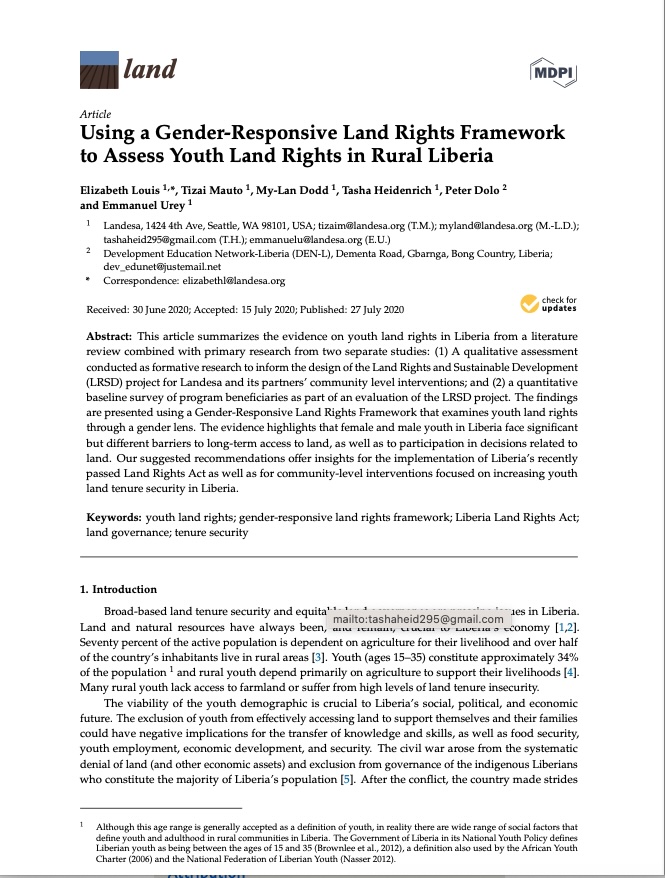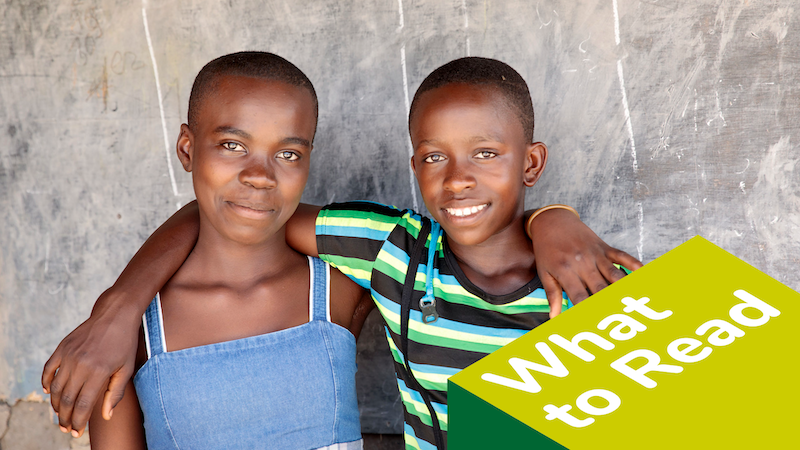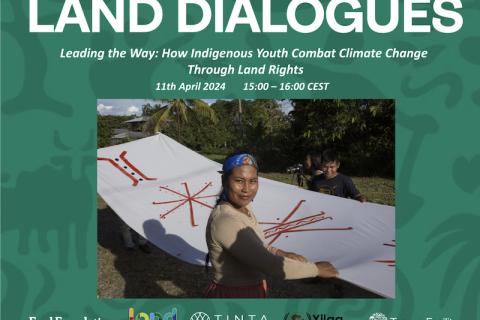This blog post is part of the series What to Read.
In times of growing land degradation, competition over fertile land, the volatility of agricultural markets and decreased interest in farming jobs, we often ask ourselves: how will the next generations cope with these challenges? Against this backdrop, it has never been more important to understand how young women and men access land, the opportunities that land-based livelihoods entail for them, and which ideas they bring to transform agricultural practices and manage natural resources in a more sustainable way.
Land is essential to start a business, produce food, or generate an income. In recent years, it has become clear that rural youth are increasingly left landless or with informal or secondary rights to land. However, the manifold challenges for youth to access land and the options to address these challenges are less understood. Obstacles that we know of include age-discriminating land tenure systems and customary practices; over reliance on inheritance to access land, in combination with delayed inheritance as a result of increasing life expectancy; and undeveloped land rental and sales markets in addition to a lack of access to finance and resources to buy or rent land. Many young women and men have inadequate access to information and legal protection of their land rights. Moreover, youth tend to be excluded from land management and decision-making.
In contrast to available data on how men and women or Indigenous Peoples and customary communities access land, there is no youth-disaggregated data related to land use or tenure security available. This is not only a matter of priority but the category “youth” also raises conceptual questions. Youth is relational to the generation in charge and hence transcends the age narrative. The World Bank defines youth as a stage of life rather than age. For instance, in West Africa it is common to refer to people in their 50s as “youths” if their parent generation is still in power. This makes it difficult to develop adequate indicators. Respectively, censuses and tenure security-related data sets such as from World Bank and Prindex only consider adult populations from 18 years. UNCCD and other UN agencies define the age of youth between 18-35 years.
Reflecting on this, I read three recent articles that focus on rural youth in the Global South, including cases from Bolivia, Liberia, Ecuador, India, Uganda, and the Philippines. The first paper highlights the perspectives of Indigenous youth and their aspirations as well as constraints to engage in land and resource governance. The second publication brings an intersectional take on young women and men in accessing land in rural West Africa. The last research piece closes with an empowering note on the role of youth in ecosystem restoration.
Sign up here to receive this digest in your mailbox
Understanding the role of youth in Indigenous territorial governance
By Maria P. Sarigumba, Marlene Soriano, James P. Robson, Ignacio Quiviquivi, and Olga L. Cabrera, 2023

This research piece offers original insights into Indigenous youth-inclusive land governance in Bolivia. In contrast to most other papers, the authors investigate youths’ perspectives and engagement (obstacles) in land-related decision making. Drawing on five years of collaborative and participatory research with the Indigenous-controlled Territory of Lomerío, the authors conducted initial workshops to better understand the aspirations of young men and women, followed by focus group and semi-structured interviews, and participating in a youth gathering event that partly functioned as a reminder to the authorities of their commitments made to the youth. The analysis also includes an overview of how youth rank their tenure security, territorial dependence, and territorial governance. However, the perception of youth tenure security is only touched upon briefly.
Although the findings indicate that young men and women are keen to be actively involved in decision-making processes, they also face certain limitations in participating in territorial governance. This mainly involves a lack of trust in youth-led decisions. Despite being included in land management and governance by the age of 18, it is more senior community members who decide on bigger land-related issues eventually. The paper shares three key lessons: Firstly, certain norms which value young people need to be in place. Second, in a welcoming environment youth will take part in community decisions which lays the foundation for meaningful engagement and sharing their ideas. Third, based on this, young people will find their own role and place in community and land-related decision-making. This will take time but enable young women and men to mobilize to bring about the change they want to see in the long run. The authors provide detailed insights into their approach to invite further participatory research on youth and land governance in other Indigenous contexts in Latin America and beyond. ;
Using a Gender-Responsive Land Rights Framework to Assess Youth Land Rights in Rural Liberia
By Elizabeth Louis, Tizai Mauto, My-Lan Dodd, Tasha Heidenrich, Peter Dolo, and Emmanuel Urey, 2020

This article belongs to a Special Issue on Land, Women, and Youths and provides an intriguing analysis on youth land rights in Liberia. Based on evidence from a qualitative assessment for the design of a Landesa project and a quantitative baseline survey as part of the evaluation of the same, the authors analyze youth land rights through a gender lens. This intersectional approach allows detailed insights into livelihood opportunities, land access, and governance constraints for young men and women in Bong, Lofa, and Rivercess counties.
In reference to the Land Rights Act of 2018, the authors examine the definition, knowledge of, and ability to access the complete bundle of land rights for youth and their enforcement in the face of contestation. Moreover, the paper critically outlines whether existing land governance is inclusive and gender equitable. While these key questions are examined in detail, the gender-lens approach would have benefitted from a more integrated discussion of young women’s and men’s experiences and limitations.
The study demonstrates that most young people have a good understanding of the exclusion mechanisms in place but lack a full understanding of their own rights. The authors’ findings show how the customary tenure system - which is dominated by older men who decide on land access opportunities and land-related questions - leads to increasing intergenerational tensions. There is a lack of youth-adult forums to discuss land matters and at the same time, youth lack access to non-confrontational dispute resolution mechanisms. The authors conclude that on an individual level, land rights education and awareness raising are critical, whereas customary authorities and heads of landowning families need to be sensitized to engage more youths in community land governance in the long term.
Youth Engagement in Land Ecosystem Restoration
By Sandra Delali Kemeh, Alan Anis, and Mirhage Kabalan, 2021

This UNCCD working paper provides insights into the restoration movement in the UN Decade of Ecosystem Restoration (2021-2030). It highlights challenges young people – aged 30 or younger - face in five different land and ecosystem restoration projects. The authors develop a typology of youth engagement based on findings from the case studies in Kaziranga Tiger Reserve (India), Action for Conservation (UK), Rakai Environmental Conservation Programme (Uganda), Reserva: The Youth Land Trust (Ecuador), and a post-typhoon cacao project (Philippines). The paper zooms into each project analyzing the socio-economic setting, funding, implementation scale and style, monitoring, and impact, and closes with a presentation of lessons learnt and recommendations. Despite the number of case studies, the paper offers a rather holistic take on the pivotal and diverse role of youth in implementing the restoration agenda. At the outset, the authors discuss obstacles that hinder youth entrepreneurship and their engagement in restoring land, including the lack of education and capacities, insufficient income and financial resources, insecure land tenure, and gender constraints. However, in the following the working paper presents – in contrast to most writings - a transformative vision of young people’s engagement in the restoration agenda at different scales. Against this backdrop, the paper calls for building more youth constituencies to utilize the knowledge, innovation, energy, and capacities of youth for sustainable development, and for developing toolkits to facilitate inclusive youth involvement in national environmental policy making. The authors hope that the successes inspire governments, donors, and civil society to further engage youth in land and ecosystem restoration.
This may also interest you:



